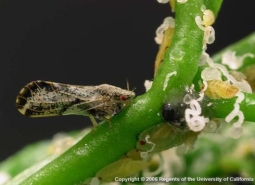This is the abstract of a presentation that was made at the recent Huanglongbing Conference held in Orlando, FL. This and other paper abstracts will soon be available at: http://irchlb.org/files/33373ab0-7df3-4117-9.pdf
Spray application of different kaolin formulations on sweet orange plants disrupt the settling and probing behavior of Diaphorina citri
M. Miranda1, O. Zanardi1; H. Volpe1; R. Garcia1; N. Roda2, E. Prado3
1 Fundecitrus, Araraquara, Brazil, 2 Tessenderlo Kerley, Inc./NovaSource, Phoenix, USA, 3 Universidade Federal de Lavras, Lavras, Brazil.
Abstract: The psyllid Diaphorina citri is the vector of the bacteria associated with huanglongbing (HLB), which is the most destructive citrus disease worldwide. Chemical control is the primary tactic against this insect. However, alternative methods are important to achieve a more effective control in an integrated pest management programs. Thus, this research was carried out to assess the influence of different kaolin formulations on the settling and probing behavior of D. citri. In both studies, two wettable powder (WP) kaolin formulations (Tessenderlo Kerley, Inc./NovaSource) were sprayed three times at different concentrations on sweet orange plants. In the experiment to assess the settling behavior, three concentrations (3, 5 and 7% w/v) of both formulations were tested. A non-choice test was performed, where 16 adult psyllids were released in a cage with seedlings of the same treatment, and the number of psyllids/plant at different time intervals was counted. For the probing trial, the electrical penetration graph (EPG) technique was used. Adult psyllids were monitored for 6 h on nursery citrus trees treated with two kaolin formulations at 3 and 5% w/v. The two kaolin formulations have a repellent effect on D. citri, causing an overall reduction of 40% of psyllids settled on treated seedlings compared with untreated control. Moreover, both formulations disrupt D. citri probing behavior, with a significant reduction (60%) in the proportion of psyllids that reach the phloem compared with untreated nursery citrus trees. In general, there were no differences between the kaolin formulations and among the concentrations tested in both experiments (settling and probing). Then, both formulations could be used in an integrated D. citri management program. These findings reinforce the recommendation of kaolin application on young citrus planting as a useful strategy for HLB management, mainly on the edge of the farms.
Photo: ACP Feeding
X
Attached Images:
